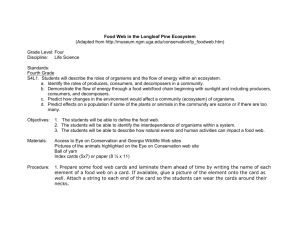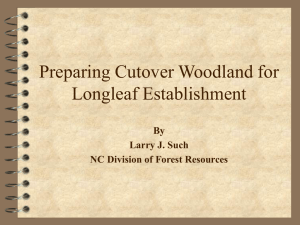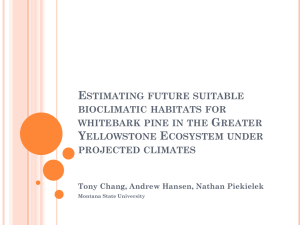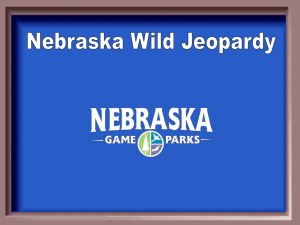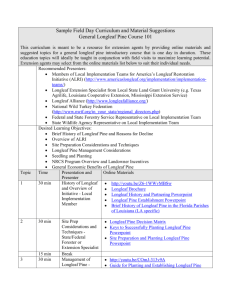Managing Longleaf Pine for Wildlife Powerpoint
advertisement
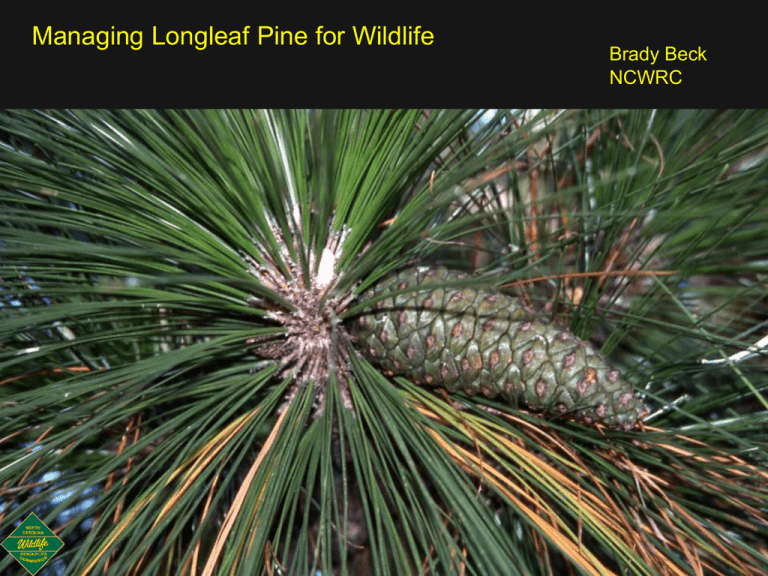
Managing Longleaf Pine for Wildlife Brady Beck NCWRC Why Longleaf Pine? Only 3% of original range is still Longleaf http://www.longleafalliance.org/ecosystem/maptoday.htm Ecosystem supports a whole suite of species that occur nowhere else Probably more important than the Longleaf trees themselves, the wiregrass/forb groundcover is under increasing pressure due to conversion, fire suppression, development, canopy closure… More resistant to Southern Pine Beetle attacks than Loblolly (Important in a fire maintained ecosystem) Longleaf pine & associated species are a State Wildlife Action Plan priority NC’s Wildlife Action Plan Provides information on the state of our wildlife resources Identifies priority species and habitats Identifies strategies and priorities for conservation work Stresses opportunities for collaboration Overall Management Goals •Thin pine stands to allow sunlight to hit forest floor •Prescribed Burn •Encourage native grass and forb communities (fire, control competition, reduce closed canopy situations) •Minimize soil disturbance in site prep operations •Encourage natural regeneration where possible (less soil disturbance, cheaper, no site prep) •Growing season burns promote natural regeneration of Longleaf •Maintain early successional openings through burning, mowing, or plantings Thin and Burn Left side was thinned to about 25 ft2, planted with Warm Season Grass, and burned several times. Winter 2002 Summer 2009-- both sides thinned and burned Prescribed Fire •Burn stands on a 2-5 year rotation •Reduce fuels with dormant season fires before attempting growing season burns •Time burns to fuel conditions as well as desired effect •Growing season burns result in more vigorous plant response and more diverse groundcover, but may incur some initial tree mortality •Vary burn block size and location so there are burned and unburned areas adjacent to one another Burn Map •Prescribed fire is the main tool the WRC uses to reduce fuels, and improve wildlife habitat for all of the species we are going to talk about •Burn units are spread out over the GL so that unburned habitat is present throughout the year Groundcover Restoration Herbicide Use •Herbicides can be useful tools for controlling undesirable vegetation and allowing more sunlight to reach the forest floor •Care should be taken to avoid treatment of sensitive plant locations •This stand was treated with Velpar ULW and then burned •The resulting grass response benefits many species of wildlife Snag Management •Maintain as many snags on the landscape as possible •Birds such as woodpeckers, nuthatches, owls, kestrels, and bluebirds benefit from good snag mgt. •Several species of snakes live under the bark of dead pines •Snags provide nesting and foraging opportunities •Most burn programs create snags, they also can get burned up in prescribed burns Quail •Keep as much of ground in direct sunlight as possible •Control plant succession to maintain diversity of grasses and forbs in understory •Control hardwood invasioncompetition •Fire is important to maintain ground cover, forb diversity, and areas to forage on insects •Legumes are important food source for quail •Quail chicks need areas to forage for insects – young chicks need protein they get from the insects Quail (Continued) •Want to establish and maintain openings in timber stand for quail (logging deck, skidder trails, Field borders, etc.) •Good habitat for 2-4 years following longleaf regeneration cuts •Longleaf pine is better suited for quail management than loblolly, slash, and shortleaf pine •Longleaf seed are highly nutritious and favored by quail •Prescribed fire applied in the winter months works well to establish suitable quail habitat in longleaf pine stands as well as stands of ragweed, partridge pea, and lespedeza •When grass becomes thick and matted, the areas should be burned to allow quail to scratch forage on the ground under the grass •Frequently burned streamhead pocosins can provide good nesting and foraging habitat •Quality quail habitat will support one covey of 9-14 quail per 20 acres White Tailed Deer •Prescribed fire will increase the forb and legume diversity in timber stands, which are good deer foods •Regeneration areas create good deer habitat by allowing sunlight to hit the ground and promote the growth of herbaceous foods that deer need •Regeneration areas that are thick can also provide good bedding areas for deer •Open areas in timber stands are good areas for food plots (logging decks, skidder trails, etc.) •Burning in late winter and early spring helps to promote native legumes and quick green up and relatively quick food sources for deer •Thinning stands to 50-60 square feet of basal area allows sunlight to hit the ground •Deer require much larger areas than the other game species mentioned, so Landowners may have to convince their neighbors to manage in a similar fashion Turkey • Pockets of mast producing oaks provide needed forage for turkeys • Open areas are needed for insect foraging chicks • High quality habitat will support 1 turkey per 30 acres and a flock of 18-20 turkeys per square mile • Turkeys forage on green leaves and grasses in the spring • In the summer and fall, preferred foods are berries, fruits, ripened seed heads and insects • Acorns are the most important food to turkeys in the winter Fox Squirrel •Longleaf seeds are an important food source •Each cone can contain as many as 100 seeds totaling up to 5,000 calories •Cavity or leaf bunch nesters, so snags and old pileated woodpecker cavities can provide important nesting sites •Artificial nests (old tire type nests or wooden boxes) are effective for improving nesting habitat •Maintain open stands (thin and burn) with diverse groundcover and scattered hardwood mast producers •Important seed dispersers- they are scatter cachers Reptiles and Amphibians •Manage upland pools for early successional conditions •Coarse/woody debris provides cover for herps •Rotting stumps create habitat for snakes and other reptiles and amphibians •Maintain and encourage as diverse a grass and forb groundcover layer as possible (growing season fire, open canopy) •Many frogs, salamanders, and snakes benefit from burned LL drains •Minimize soil compaction Wildlife Action Plan – Reptiles and Amphibians that use Longleaf Pine Eastern Tiger Salamander (T) Oak Toad (SR) Ornate Chorus Frog (SR) Carolina Gopher Frog (T) Eastern Diamondback Rattlesnake (E) Southern Hog-nosed Snake (SC) Eastern Coachwhip (SR) Eastern Coral Snake (E) Northern Pinesnake (SC) Pigmy Rattlesnake (SC) Seasonal Pond Restoration Seasonally dry pond grown up in trees Many rare frogs and salamanders depend on isolated wetlands for breeding. Historically, these seasonally dry ponds were kept free of trees by fire. Without fire, these habitats are invaded by woody vegetation, making them unsuitable for many of the species that depend on them. To restore these habitats, land managers must remove the invading hardwoods and reintroduce fire. The same pond in winter after tree removal. Red-Cockaded Woodpeckers (Federally Endangered) •Nest in old, live pine trees •Cavities take up to 12 years to complete •Require 60-500 acres of foraging habitat per group of birds •Good foraging habitat is typically at least 30 years old pine with a BA of 50-70, prefer older stands and larger trees •FWS guidelines suggest managing RCW habitat for at least 40% native grass/forb groundcover •Prescribe burn 2-5 year rotation •Control mid-story hardwoods (keep below 7’) •Provide artificial cavities where groups have fewer than 4 suitable cavities •Requires OLD (80+ yrs) stands for nesting habitat Other Birds to consider Large snag cavity nesters Grassland/shrubland nesters •Keep a few large diameter snags per acre •Maintain some open shrubby fields •Screech owls, bluebirds, woodpeckers, nuthatches will all benefit Bachman’s Sparrow (FSC) •Longleaf Pine- Wiregrass specialist •Ground nesters •Best habitat is year 1 and 2 after a burn Brown Headed Nuthatch •Cavity nesters •They use small diameter snags, relatively close to the ground •Relatively easy to create habitat for themkeep some small snags on the landscape •Eat LL seeds Wildlife Action Plan – Birds and Mammals that use Longleaf Pine Bachman’s sparrow (SC) Henslow’s Sparrow (SR) Red-cockaded Woodpecker (E) Eastern Fox Squirrel (SR) Burn Baby Burn…… Additional Resources: Longleaf Alliance http://www.longleafalliance.org/ USFWS RCW Recovery http://www.fws.gov/rcwrecovery/ USFWS Partners for Fish and Wildlife http://www.fws.gov/southeast/partners/pfwpine.html NC Wildlife Resources Commission- State Wildlife Action Plan http://www.ncwildlife.org/plan/index.htm
